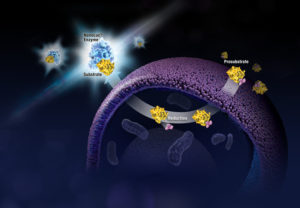 What if you could uncover a small but significant cellular response as your population of cells move toward apoptosis or necrosis? What if you could view the full picture of cellular changes rather than a single snapshot at one point? You can! There are real-time assays that can look at the kinetics of changes in cell viability, apoptosis, necrosis and cytotoxicity—all in a plate-based format. Seeking more information? Multiplex a real-time assay with endpoint analysis. From molecular profiling to complementary assays (e.g., an endpoint cell viability assay paired with a real-time apoptosis assay), you can discover more information hidden in the same cells during the same experiment.
What if you could uncover a small but significant cellular response as your population of cells move toward apoptosis or necrosis? What if you could view the full picture of cellular changes rather than a single snapshot at one point? You can! There are real-time assays that can look at the kinetics of changes in cell viability, apoptosis, necrosis and cytotoxicity—all in a plate-based format. Seeking more information? Multiplex a real-time assay with endpoint analysis. From molecular profiling to complementary assays (e.g., an endpoint cell viability assay paired with a real-time apoptosis assay), you can discover more information hidden in the same cells during the same experiment.
Whether your research involves screening a panel of compounds or perturbing a regulatory pathway, a more complete picture of cellular changes gives you the benefit of more data points for better decision making. Rather than assessing the results of your experiment using a single time point, such as 48 hours, you could monitor cellular changes at regular intervals. For instance, a nonlytic live-cell reagent can be added to cultured cells and measurements taken repeatedly over time. Pairing a real-time cell health reagent with a detection instrument that can maintain the cells at the correct temperature means you can automate the measurements. These repeated measurements over time reveal the kinetic changes in the cells you are testing, giving a real-time status update of the cellular changes from the beginning to the end of your experiment.
If you are seeking a yes/no answer to a cell treatment, real-time assays will not benefit your research. However, performing a kinetic real-time experiment can demonstrate how a single endpoint measurement may miss the mechanism of action that causes cell death. When testing compounds that can modulate cancer cells, measuring the apoptotic marker every 30 minutes can reveal how time and dose affect cell death. The marker kinetics change if the cells undergo primary necrosis rather than apoptosis.
Because researchers are increasingly interested in how microenvironments influence how cells respond to a compound that may modulate gene expression or alter cell health, three dimensional (3D) cell cultures and mixed cell cultures are becoming important. Mixed cells and 3D cell cultures offer more sophisticated models that better reflect the biology of a tissue or tumor environment, making them more relevant to predicting the usability of a compound. Real-time assays could help determine if cytotoxicity in a mixed cell culture occurs at once, in progressive steps or if there is a resistant population. These factors would help in making a decision about the suitability of a compound for further investigation.
Better understanding biology means gaining more information during the course of a single experiment. Real-time nonlytic cell health assays like the RealTime-Glo™ MT Cell Viability Assay, CellTox™ Green Cytotoxicity Assay and RealTime-Glo™ Annexin V Apoptosis and Necrosis Assay offer the opportunity to continuously measure changes in cells over time for up to 72 hours. These status updates mean you can see if the cells follow a typical apoptotic profile, necrosis occurs immediately or if there is little change in cell viability during the entire experiment. Even when the real-time assay is completed, the cells have not been lysed and can be assessed for another cell health marker or nucleic acid can be extracted for further analysis. Real-time assays mean you can explore more than one aspect of the model system you are studying and gain a more complete picture of how the cells respond under experimental conditions.
Sara Klink
Latest posts by Sara Klink (see all)
- A One-Two Punch to Knock Out HIV - September 28, 2021
- Toxicity Studies in Organoid Models: Developing an Alternative to Animal Testing - June 10, 2021
- Herd Immunity: What the Flock Are You Talking About? - May 10, 2021
